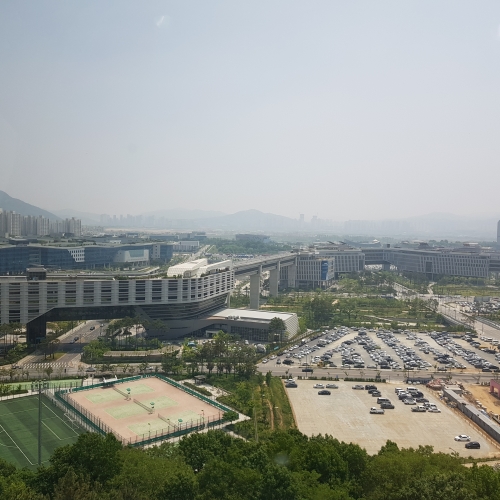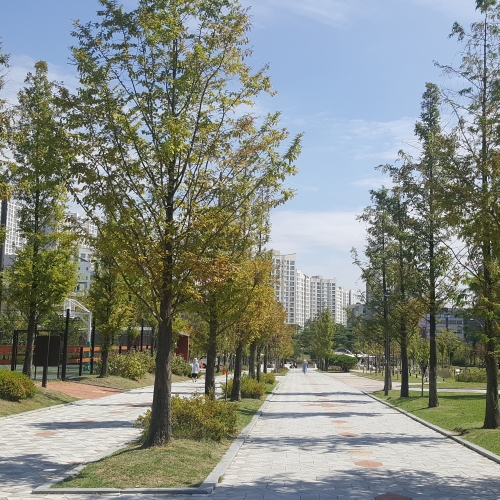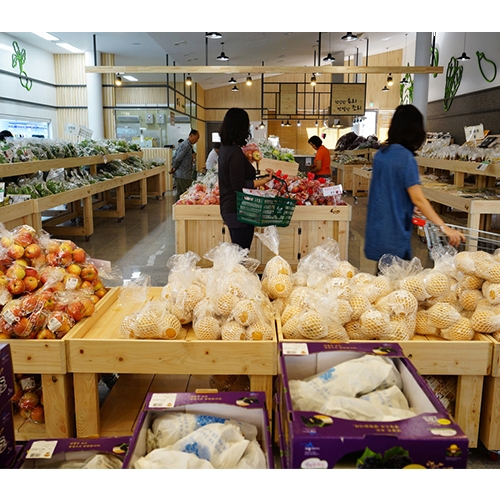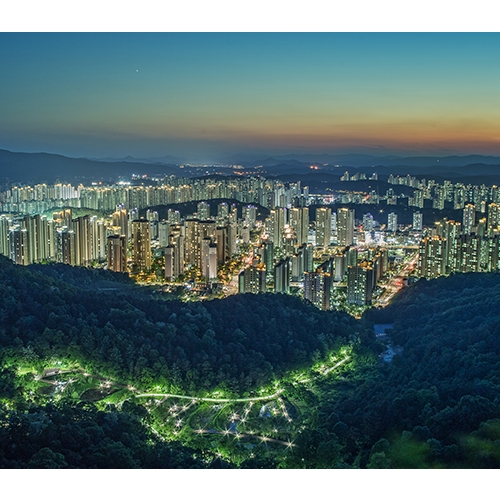Living Sejong, Reading Sejong: Questions After One Year
(1) The Development Background and the Current Situation
(2) The Characteristics of a Planned City
(3) Vitalizing the Local Community by Promoting Food Culture
(4) The Old Downtown and its Neighbouring Areas
(5) Roundtable: Understanding Sejong Today
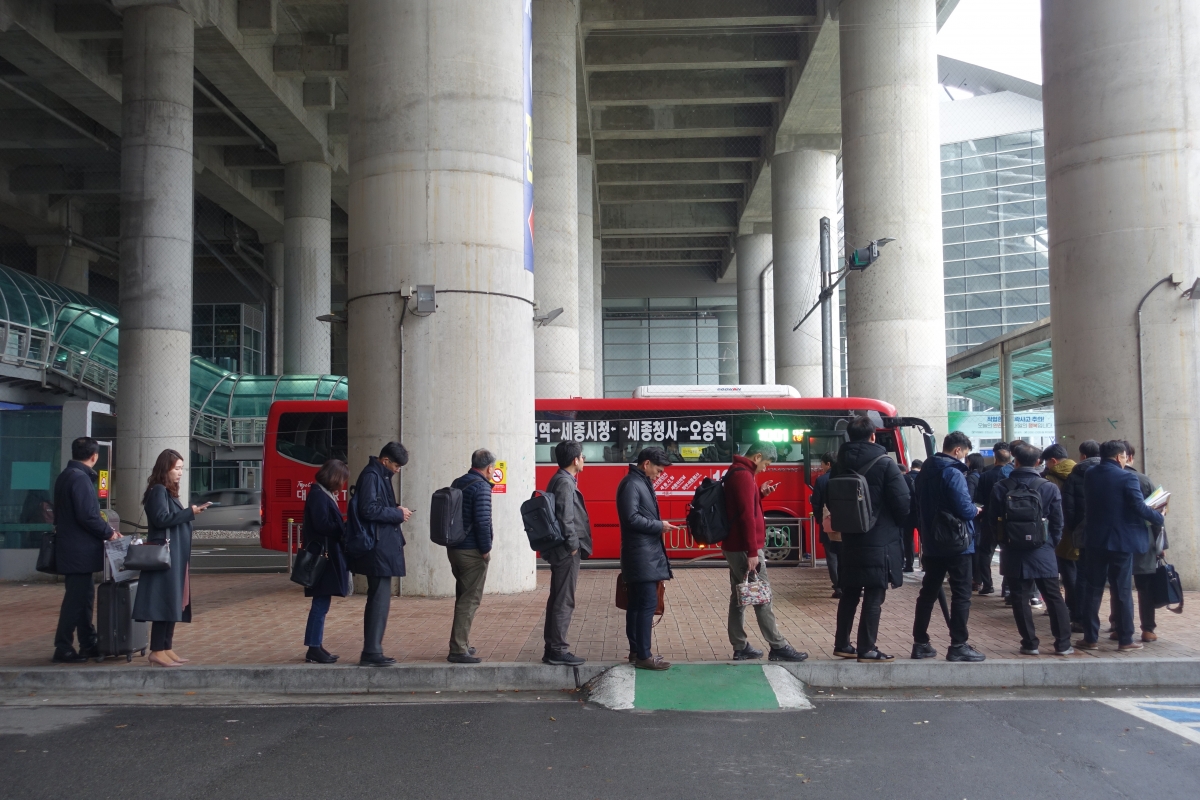
Monday morning, office workers waiting BRT from Osong Station to Sejong
(©Choi Eunhwa)
A Link-up to Sejong
Sejong borders Cheonan, Cheongju, Gongju, and Daejeon. Osong Station, the main traffic circulation point from Sejong to other cities across the country, and part of the Gyeongbu Line (Seoul – Busan), belongs to Cheongju in terms of designated administrative districts. Osong is a transportation hub that is repeatedly visited by those who live in Sejong. The planned Seoul-Sejong Expressway will pass through Gongju to Janggun-myeon of Sejong, and Sejong Station is now unlikely to be built due to opposition from adjacent cities.
To get to Sejong, people usually take the express train to Osong Station or the express bus to Sejong Terminal, but they often use the Saemaul or Mugunghwa Trains that stop at Jochiwon Station. One may wonder who will take the slow train in an era in which highspeed trains have become so popular, but many still prefer the old Jochiwon Station. Thankfully, Saemaul and Mugunghwa Trains at Jochiwon Station, which still survive today, have their own unique characteristics. When talking about Sejong, the story of Jochiwon should not be forgotten. This series illuminates Sejong’s historic living environments, a place now regarded as entirely new, and asks some questions about the city’s relationship to balance, time and change.
A balanced development of land stated in the constitution was the main background to the creation of Sejong.▼1 The national goal of cultivating a balanced national land, however, ironically causes a relative imbalance in the surrounding areas of these selected targets of development, forming unpredictable conflicts of interest between regions.▼2 When resources for development are concentrated on one place, the sense of deprivation felt by its surrounding neighbourhoods may end up implementing further measures to promote collaboration and equality of opportunity.▼3 When I think the decision to construct a high-speed train station at Osong, a new gateway to Sejong, ostensibly created in the name of balanced national development, the fierce opposition of neighbouring cities to adding Osong Station is largely due to the complicated justification of balanced growth throughout regions. I find it difficult to grasp the planning principles behind the concept of balance.
Osong Station, which opened on the 1st of November, 2010 after a long meandering path to completion, is difficult to deem great in terms of its architectural attributes. When I first visited Sejong I was amazed at the poor design of the station, but I have become numb to these aspects after using the station for four months. Apart from the design, even until now, I can’t understand the strange and inefficient traffic conditions of Sejong, as it takes 40 – 50 minutes by high-speed train from Seoul Station to Osong Station but it requires another 25 minutes from Osong Station to the office in Sejong. Although one claims it is for the balanced development of the region, the area around Osong Station does not seem to have been activated as an influential growth area over the past nine years, and the landscape around the connecting road from Osong to Sejong remains the same as that of a rural production area. Nevertheless, the number of passengers in Osong Station has increased every year, with 24,000 daily passengers in May 2019, making it the ninth most-used station of 44 high-speed train stations nationwide. It is regrettable that, considering the complaints of officials in Sejong City over inefficiency, due to their frequent business trips to Seoul, officials have contributed a lot to this increase. The crowds of officials and researchers at Osong Station, who commute to their office every Monday morning and to weekly meetings in Seoul are now a unique sight in Sejong.▼4 Director Kim and Dr. Kim, wearing their black backpacks, are on their way from Osong Station even today.
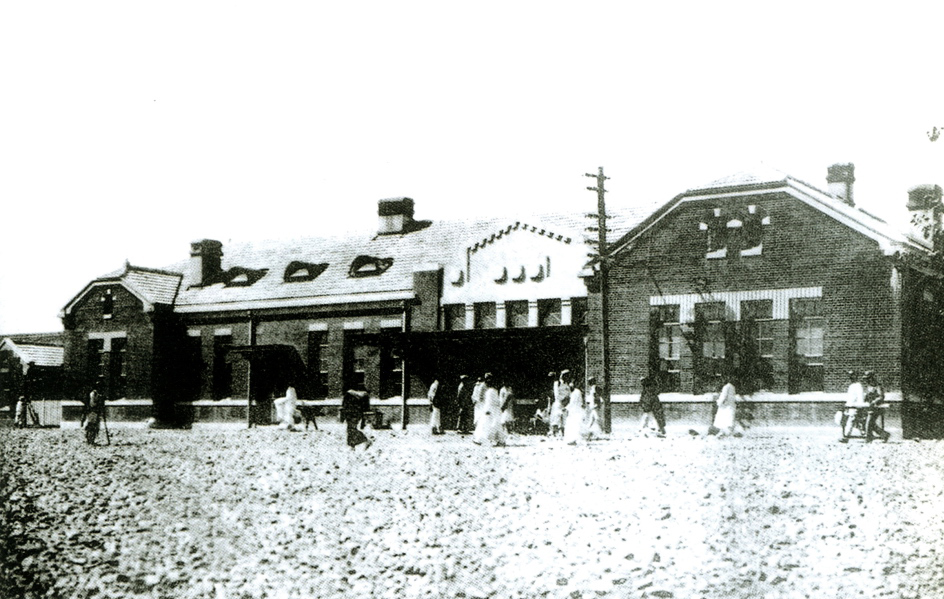
Previous Jochiwon Staion in the 1910s (©Image courtesy of Sejong Sori)
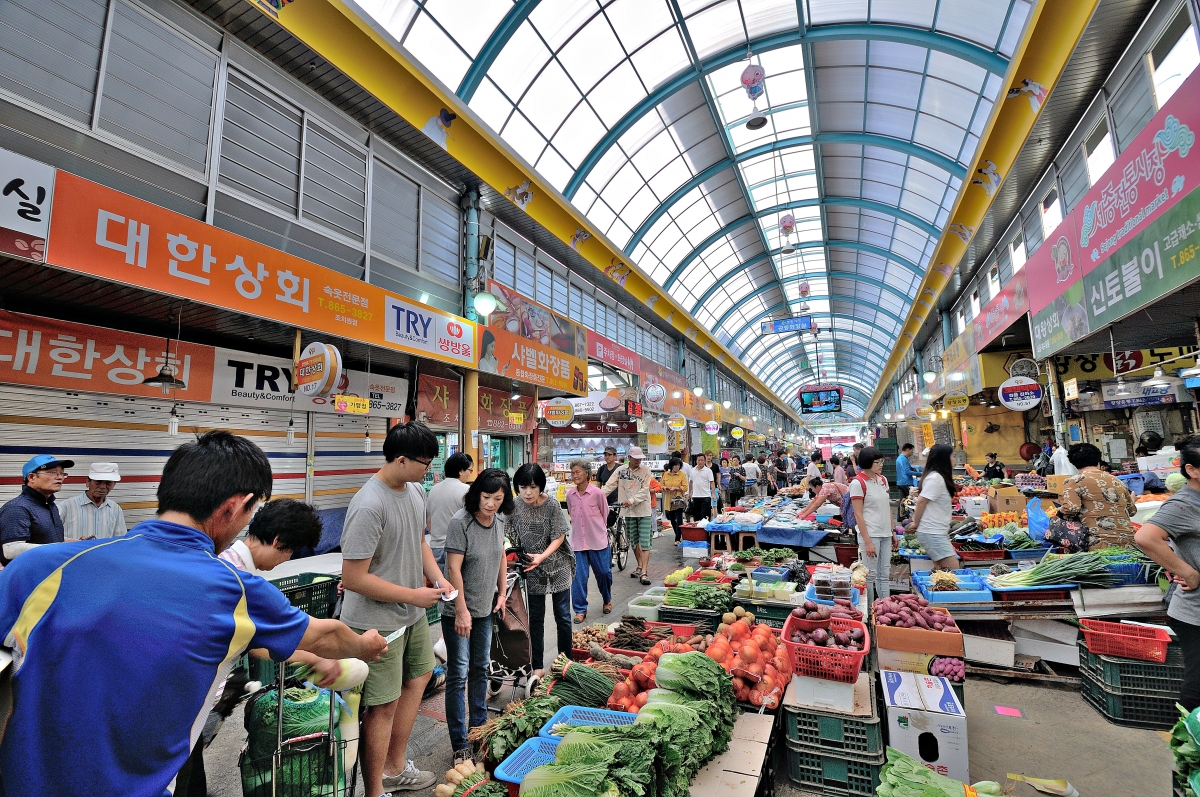
Sejong Traditional Market (©Kang Taesoo / Image courtesy of National Agency for Administrative City Construction)
Jochiwon Station and Market
Compared to the new Osong Station, with only a decade-long history since its opening, Jochiwon Station is a place worth boasting about. Serving the city since 1905, it has a sense of place grander than its one century of existence. In pictures Jochiwon Station is beautiful. Historic train stations do not usually feature as city sightseeing landmarks or as main thoroughfares, particularly when a new station is built but Jochiwon Station offers a nostalgic and touching impression of old building and continues to play its role in the city’s flow of arrivals and departures. A newly constructed area in Sejong is well served by new additions from A to Z, as well as old public buildings of the modern period all with accumulated layers of time for which they could have broadcast their historical value but they just disappeared.▼5 It’s even more regrettable as they survived throughout the 1970s, the era of development, and were replaced by new buildings in the 1990s just a few years before discussions about Sejong construction began. The current Jochiwon Station was rebuilt in October 1999, and now it boasts an appearance of popular railway station of today, but fails to capture an impression of it’s century of history. Has any particular railway station in Korea recently expressed the power of time or place in a sensitive way? Sleek, uniform glass buildings directed by function and efficiency dominate; Seoul Station, Busan Station, Dongdaegu Station, Shingyeongju Station, and Osong Station. They are all similar in that they don’t move one’s heart in terms of architecture.
Some scholars date the history of Jochiwon back to the Three Kingdoms Period, but it is typically thought that the name Jochiwon was first recorded in the late Joseon Dynasty. Meanwhile, the identity of Jochiwon as a railroad and commercial city was formed during the modern period.▼6 The Gyeongbu Line first opened in the early 20th century, and Jochiwon Station began to operate in 1905. In 1911, it lost the competition over the Honam Line Junction to Daejeon, but as it was connected to the Chungbuk Line it became the major distribution centre in Chungcheong-do. Until automobiles replaced trains as the primary means of transport in the era of the highway, which began in the 1970s, Jochiwon acted as a base for Chungcheong-do land transportation along with Daejeon. Meanwhile, before the opening of the railway station, Jochiwon’s market was nothing but ‘a marketplace in a quiet rural area’. A new marketplace was established around the station with the opening of Jochiwon Station in 1905 and the subsequent renovation of the city area in 1920 meant that the ‘new market’ was interpreted as ‘Sejong Traditional Market’, the current Jochiwon traditional market.▼7 In spite of the new expressway and the wave of hypermarkets, the Jochiwon Traditional Market remained active until the early 1990s, holding a rural five-day market.▼8 Even now, one can experience the pleasant energy of the Jochiwon traditional market.
Jochiwon Traditional Market was reborn under its official name ‘Sejong Traditional Market’ in April 2013 along with similar marketplaces in a nearby area.▼9 Although ‘Jochiwon Traditional Market’ is a more familiar name, Sejong Traditional Market became the legal official term thanks to the launch of the Sejong Metropolitan Autonomous City in 2012 which annexed Jochiwon-eup, and the 2009 amendment of the Special Act on the Development of Traditional Markets and Shopping Districts, which designated traditional markets as legal properties.▼10 The transformation of Jochiwon Traditional Market into Sejong Traditional Market also represents the subtle shift in spatial power between Sejong and Jochiwon.
A funny joke in the area is to ask how to get to Sejong from Jochiwon. Jochiwon has existed for more than a few centuries, but it became a unique subset of Sejong since 2012. Losing a competition against Daejeon, Gongju, and Cheongju, Jochiwon was already on the way towards decline, but it had an opportunity to leap forward with Sejong’s resources and vitality, and Sejong is also able to highlight the value of old place in Jochiwon calling it the ‘original downtown’ while it feels the lack of history; this clearly puts them in a win-win relationship. It is necessary to explain in detail the recent bizarre situation in which the new city received the Excellence Prize several times for the ‘Young Jochiwon’ project at several award contests that selected the best practices for urban regeneration in a declining area.▼11 The phenomenon of Jochiwon poses a very confusing urban question as to what kind of complex system can interpret the issue of so-called ‘balance’ in reality.
On the other hand, the results of the recent survey of residents conducted by the Architecture & Urban Research Institute to investigate everyday life and place better awareness of the needs of citizens in a rapidly growing Sejong are very interesting. For example, when asked about popular attractions for Sejong citizens, they selected 114 places in Sejong, and the top 10 places were as follows in descending order; emart Sejong, Sejong Lake Park, CGV Sejong, Costco Sejong, Homeplus Sejong, and National Library of Korea Sejong, Jochiwon Traditional Market, Mega City, Nasa Bowling Alley, and Homeplus Jochiwon.▼12 It is surprising and depressing that large discount marts fill a list of places frequently visited by Sejong citizens, but it is also surprising that the Jochiwon Traditional Market ranks in the top ten. I would like to argue that there is some part of urban life that cannot be satisfied by only new things and must be filled with old ones, but I can’t come to this judgment so early. Instead, Sejong forces me to note the sad reality of a lifestyle in both newly built areas and surrounding older areas is dictated by large-scale marts or traditional markets based on commercial activities, and that the present provision for a rich cultural life separate from the public sector is far from sufficient.
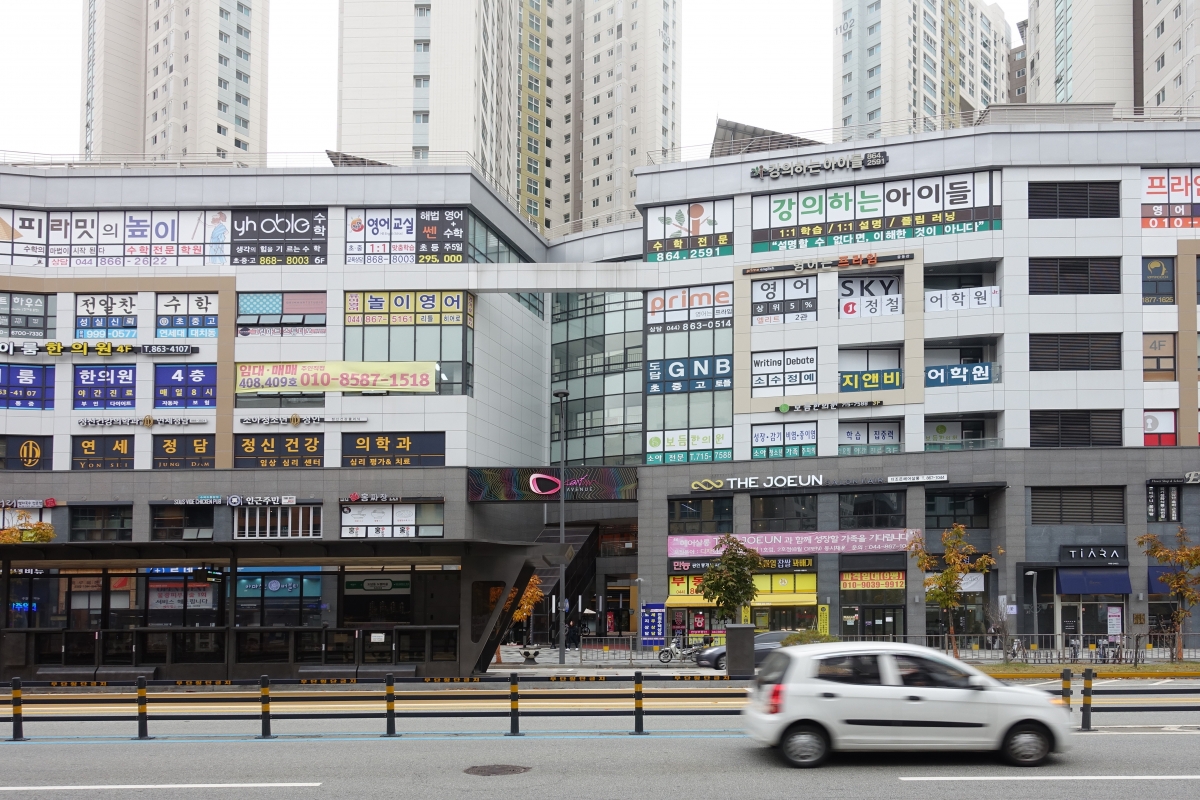
Street wall at Daram village, Dodam-dong (©Choi Eunhwa)
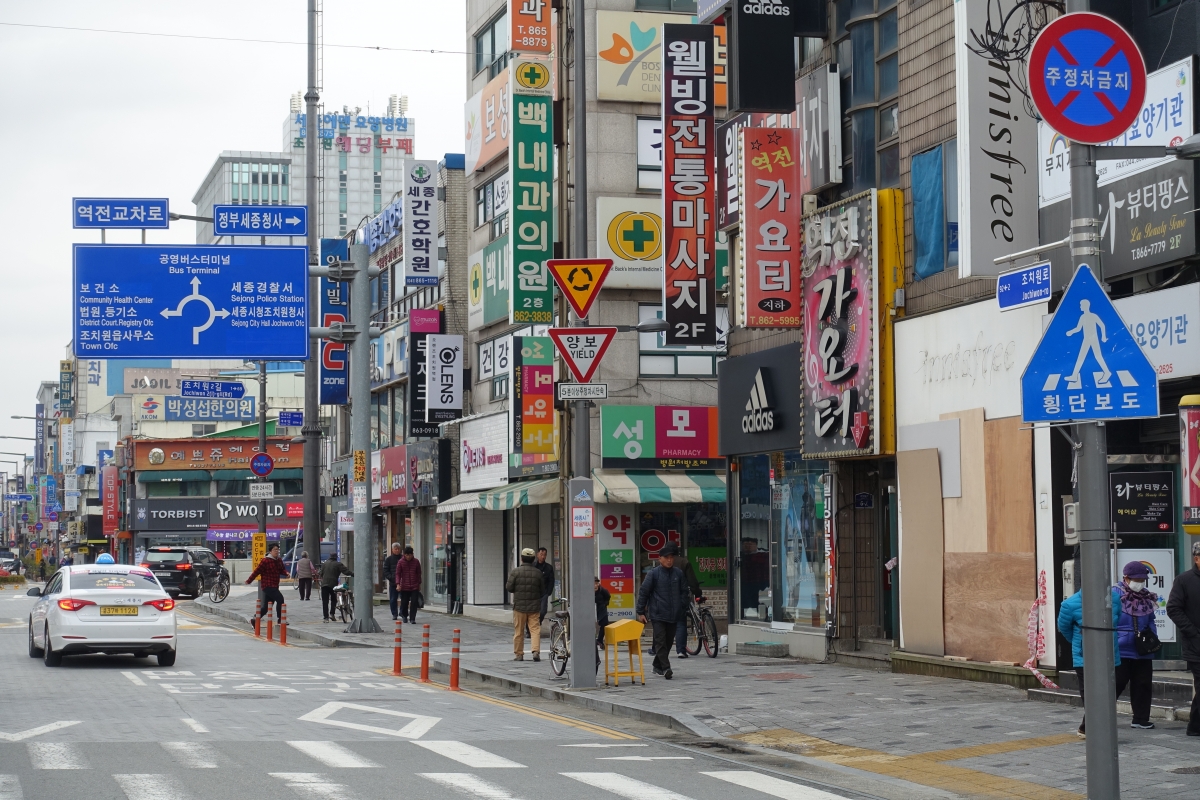
Signboards in front of Jochiwon Station (©Choi Eunhwa)
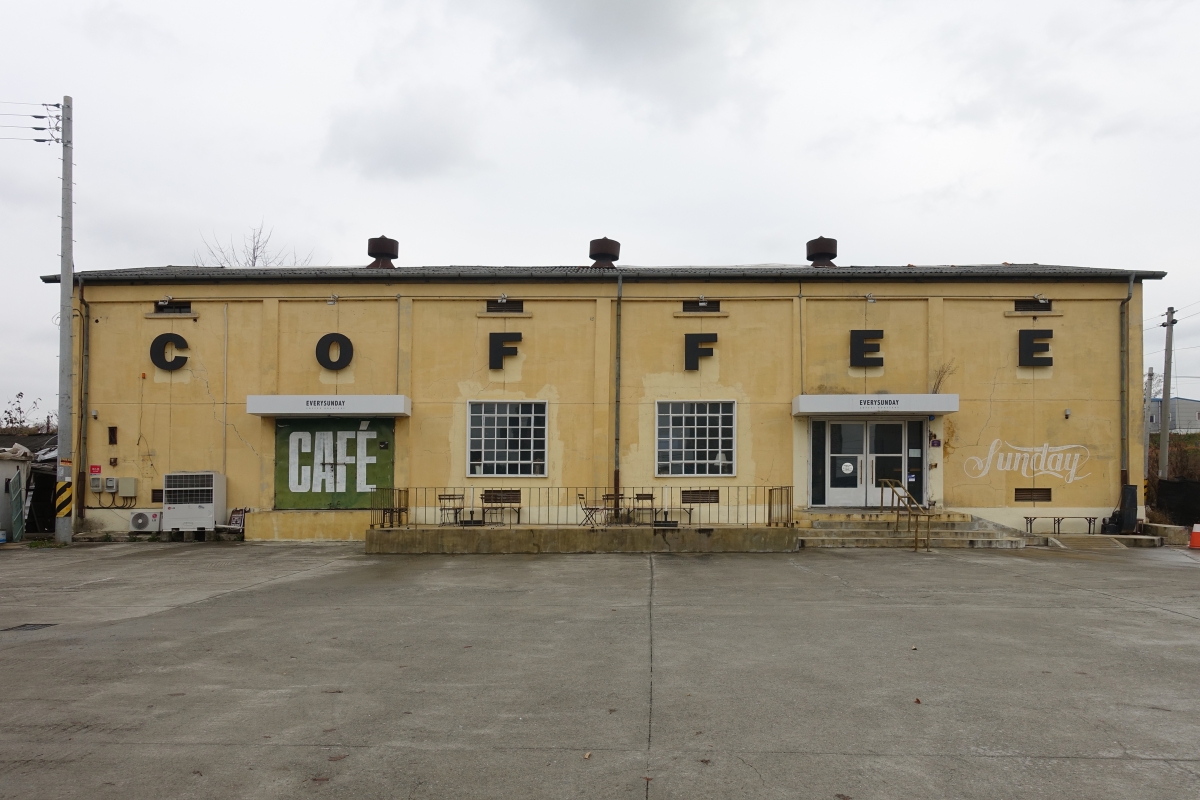
Every Sunday Coffee Bongam (©Choi Eunhwa)
Landscape of the Sejong-Jochiwon Local Road
If I were asked to pick one design element that is positioned as the representative urban feature of the newly built area in Sejong, I would choose the downtown street wall which can be seen from both sides of the Bus Rail Transit (BRT). It subtly expresses the unified landscape of street wall design, trying to adequately capture Sejong’s urban identity. It may be regarded as the simple finishing of the street façade, just like the maintenance of street signage, but management of the street wall design also requires closely linked adjustments of not only lot size, floor area ratio, building coverage, but also building height along the street, arcade, building connection, entrance design on the ground floor, elevation coverage.▼13 The wall eventually aims to create a lively public transportationoriented street and at the same time a harmonious streetscape that will enhance the quality of the pedestrian environment and vitalize commercial activity. Individual strategies to satisfy all of these needs are bound to contradict or clash with each other. Nevertheless, I can find signs of efforts to implement this in a manner of compromise, so I expect it to progress further in spite of any existing conflicts.
On the other hand, the road connecting the newly built area of Sejong with Jochiwon was widened to six lanes in 2017, but both sides of the road show the maximum chaotic landscape due to arbitrary appearance of shops built in a haphazard fashion. We may be able to stand such roadside landscapes like the shabby appearance of improvised buildings, the finishing of inaccessible walkways, and the imprudent size and design of signboards, as we rapidly pass by them in a car. This phenomenon is not confined to the road to Jochiwon but can be found any roadside in Korea’s national highway. We can hear voices of merchants who complain of excessive design restrictions on the street wall of Sejong, but many people raise their voice blaming irresponsible laissez-faire of architectural design along the road to Jochiwon.
Luckily, taking a short drive down the byway from the road to Jochiwon, one can find the Every Sunday Coffee Bongam, a former rice granary that has been transformed into a coffee shop. A warehouse building equipped with a fresh design and function stands at the end of a harsh road of hopeless rawness. Whenever I visit the warehouse located in a remote place that is inaccessible by public transportation, to find a place crowded with people brings me hope that someday we will be able to cope with complex challenges such as balanced development, urban regeneration, road environment improvement, local revitalisation, commercial street revitalisation, and street wall design.
1. Article 120, 122, 123 of Constitution of the Republic of Korea state the balanced use, development and preservation of the land of the nation, and the balanced development of all regions as the national obligation. Kang Hyeonsu and 7 et al., Reconfiguration of Balanced Regional Growth Theory, Social Thesis, 2013, p. 6.
2. Kang Kyungtae, ‘Division of Local Autonomy, Resident Self-governance and Balanced Development: Concept and Context’, the Korean Political Science Association, Division of Localization and Balanced Development: Observations of Political Scientists, Blue Road, 2018, p. 26.
3. Byun Changheum, ‘The Necessity and Issues of Balanced Regional Development’, Kang Hyunsoo and 7 et al., Reconstruction of Balanced Regional Development Theory, Social Criticism, 2013, p. 80.
4. Newsis, 22 June 2019.; JoongAng Ilbo, 7 July 2018.
5. Architecture & Urban Research Institute, “Reorganization of Public Buildings in Jochiwon-eup”, 2017, pp. 11 – 16.
6. Oh Sukmin · Lee Dongjung, History and Jiangxi of Chochiwon, Railway City, Sejong Metropolitan Autonomous City and the National Folk Museum, 2016.; Oh Sukmin, ‘The End of the Golden River’s Old Vessel, the Old Port and Jiangxi of Sejong City’, Sejong Metropolitan Autonomous City · National Folk Museum, Folk Cultures in Sejong, vol. 4, 2016.
7. Oh Sukmin · Lee Dongjung, p. 80.
8. Oh Sukmin · Lee Dongjung, p. 81.
9. Sejong Metropolitan Autonomous City, Sejong Traditional Market, [https://www.sejong.go.kr/kor/ sub04_030101.do].
10. Park Hana, “The Urban & Spatial Characteristics of Small and Medium-sized Traditional Markets Activated”, Journal of the Architectural Institute of Korea, Vol. 33, no. 12, Dec. 2017, p. 73.
11. Sejong Metropolitan Autonomous City, ‘Planning for Urban Regeneration of Urban Regeneration in the Urban Regeneration Front Area of Jochiwon One-Won’, June, 2018; Sejong Metropolitan Autonomous City, ‘Winning the Best Urban Regeneration Award in the Youth Action Center Project’, 17 Apr. 2019.
12. Lee Jongmin, ‘Daily Life and Place Recognition of Sejong Citizens’, Sejong Metropolitan Autonomous City · Architecture & Urban Research Institute, Announcement of the 2019 Sejong Forum, p. 91.
13. Architecture & Urban Research Institute, Guidelines for Designing Street Walls in Multifunctional Administrative City, Policy Research Report, 2017, pp. 3 – 5.
study areas include urban conservation, neighborhood walking, and community planning, with research-based design approaches. She was a member of Presidential Commission on Architecture Policy; Prime Minister Office’s Commission on Urban Regeneration; National Cultural Heritage Committee, and Urban Planning Committee of Seoul. Her recent publications include Neighborhood Walking Neighborhood Planning (SPACE BOOKS, 2015) and ‘Seoul Streets—Ironic 5 Places of Urban Stories’ (SPACE, Mar. – Sep. 2017).





